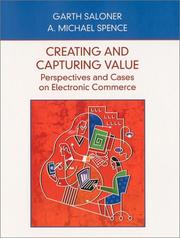| Listing 1 - 10 of 10 |
Sort by
|
Book
Year: 1992 Publisher: Cambridge, Mass. National Bureau of Economic Research
Abstract | Keywords | Export | Availability | Bookmark
 Loading...
Loading...Choose an application
- Reference Manager
- EndNote
- RefWorks (Direct export to RefWorks)
Book
Year: 1992 Publisher: Cambridge, Mass. National Bureau of Economic Research
Abstract | Keywords | Export | Availability | Bookmark
 Loading...
Loading...Choose an application
- Reference Manager
- EndNote
- RefWorks (Direct export to RefWorks)

ISBN: 0471410152 9780471410157 Year: 2002 Publisher: New York Wiley
Abstract | Keywords | Export | Availability | Bookmark
 Loading...
Loading...Choose an application
- Reference Manager
- EndNote
- RefWorks (Direct export to RefWorks)
Computer architecture. Operating systems --- Distribution strategy --- Electronic commerce --- Cybercommerce --- E-business --- E-commerce --- E-tailing --- eBusiness --- eCommerce --- Electronic business --- Internet commerce --- Internet retailing --- Online commerce --- Web retailing --- Commerce --- Information superhighway --- Electronic commerce.

ISBN: 0471380717 9780470009475 9780471380719 Year: 2001 Publisher: New York Wiley
Abstract | Keywords | Export | Availability | Bookmark
 Loading...
Loading...Choose an application
- Reference Manager
- EndNote
- RefWorks (Direct export to RefWorks)
Business policy --- Strategic planning --- Strategic planning. --- Social Sciences and Humanities. Management studies, Business Administration, Organizational Science --- Strategic Policy --- 658.112 --- Site, location, place of business --- 658.112 Site, location, place of business --- Strategic Policy. --- Goal setting (Strategic planning) --- Planning, Strategic --- Strategic intent (Strategic planning) --- Strategic management --- Planning --- Business planning
Book
Year: 1984 Publisher: Cambridge, Mass. National Bureau of Economic Research
Abstract | Keywords | Export | Availability | Bookmark
 Loading...
Loading...Choose an application
- Reference Manager
- EndNote
- RefWorks (Direct export to RefWorks)
This paper studies implicitly colluding oligopolists facing fluctuating demand. The credible threat of future punishments provides the discipline that facilitates collusion. However, we find that the temptation to unilaterally deflate from the collusive outcome is often greater when demand is high. To moderate this temptation,the optimizing oligopoly reduces its profitability at such times,resulting in lower prices. If the oligopolists' output is an input to other sectors, their output may increase too. This explains the co-movements of outputs which characterize business cycles. The behavior of the railroads in the 1880's, the automobile industry in the 1950's and the cyclical behavior of cement prices and price-cost margins support our theory. (J.E.L. Classification numbers:020, 130, 610).
Book
Year: 1986 Publisher: Cambridge, Mass. National Bureau of Economic Research
Abstract | Keywords | Export | Availability | Bookmark
 Loading...
Loading...Choose an application
- Reference Manager
- EndNote
- RefWorks (Direct export to RefWorks)
This paper seeks to explain why monopolies keep their nominal prices constant for longer periods than do tight oligopolies. We provide two possible explanations. The first is based on the presence of a small fixed cost of changing prices. The second, on small costs of discovering the optimal price. The incentive to change price for duopolists producing differentiated products exceeds that of a single monopolistic firm which produced the same tange of products as the duopoly.
Monopolies --- Pricing --- Econometric models.
Book
Year: 1986 Publisher: Cambridge, Mass. National Bureau of Economic Research
Abstract | Keywords | Export | Availability | Bookmark
 Loading...
Loading...Choose an application
- Reference Manager
- EndNote
- RefWorks (Direct export to RefWorks)
This paper shows that the imposition of an import quota by one country can lead to increased competitiveness; protection can reduce the price in the country that imposes the quota, the foreign country, or both. This emerges from a model in which the firms are assumed to sustain collusion by the threat of reversion to more competitive pricing. We consider both prices and quantities as the strategic variables and study competition both in the domestic and the foreign market taken individually, and in the two markets taken together.
Book
Year: 1992 Publisher: Cambridge, Mass. National Bureau of Economic Research
Abstract | Keywords | Export | Availability | Bookmark
 Loading...
Loading...Choose an application
- Reference Manager
- EndNote
- RefWorks (Direct export to RefWorks)
The literature on networks suggests that the value of a network is positively affected by the number of geographically dispersed locations it serves (the "network effect") and the number of its users (the "production scale effect"). We show that as a result a firm's expected time until adoption of technologies with network effects declines in both users and locations. We provide empirical evidence on the adoption of automated teller machines by banks that is consistent with this prediction. Using standard duration models, we find that a bank's date of adoption is decreasing in the number of its branches (a proxy for the number of locations and hence for the network effect) and the value of its deposits (a proxy for number of users and hence for production scale economies). The network effect is the larger of the two effects.
Book
Year: 1990 Publisher: Cambridge, Mass. National Bureau of Economic Research
Abstract | Keywords | Export | Availability | Bookmark
 Loading...
Loading...Choose an application
- Reference Manager
- EndNote
- RefWorks (Direct export to RefWorks)
We consider a model with several regions whose technological ability and factor endowments are identical and in which transport costs between regions are non-negligible. Nonetheless, certain goods are sometimes produced by multiple firms all of which are located in the same region. These goods are then exported from the regions in which their production is agglomerated. Regional agglomeration of production and trade stem from two forces. First, competition between firms for the services of trained workers is necessary for the workers to recoup the cost of acquiring industry-specific human capital. Second, the technology of production is more efficient when plants are larger than a minimum efficient scale and local demand is insufficient to support several firms of that scale. We also study the policy implications of our model.
Book

ISBN: 9781400845354 Year: 2012 Publisher: Princeton, NJ
Abstract | Keywords | Export | Availability | Bookmark
 Loading...
Loading...Choose an application
- Reference Manager
- EndNote
- RefWorks (Direct export to RefWorks)
| Listing 1 - 10 of 10 |
Sort by
|

 Search
Search Feedback
Feedback About UniCat
About UniCat  Help
Help News
News